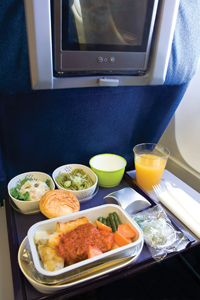
Features
Operations
Alternate Approach: The problem is piling up
Every year the U.S. airline industry tosses out enough cans to fill the aluminum content of 58 Boeing 747s, according to the National Resources Defense Council (NRDC), a New York-based environmental think tank.
July 14, 2010 By David Carr
Every year the U.S. airline industry tosses out enough cans to fill the aluminum content of 58 Boeing 747s, according to the National Resources Defense Council (NRDC), a New York-based environmental think tank.
These comparisons are well intentioned, sometimes suspect and always effective in helping to get the message across. The NRDC’s calculation is from 2004. Six years later, will the number of aluminum cans sent to landfill produce more or fewer 747s? Nothing curbs the packaging waste stream faster than a recession and fewer customers.
 |
|
| The greatest barrier to recycling is a disconnect between airlines and airports, the entry and end point for all disposable waste.
|
What is clear, however, is that recycling lags behind alternative fuel sources, lighter aircraft and more efficient engines in the race for a greener airline industry. The average passenger generates approximately half a kilogram of waste of which 75 per cent is recyclable, but only 20 per cent recycled.
Approximately 50 per cent of package waste flows from the cabin. Green America, a Washington-based environmental group that advocates market solutions, recently published a dismal report card on nine U.S. domestic and two international airlines. The group found that while cabin service at all airlines is heavily dependent on disposable packaging, no carrier either recycles all major recyclables or has programs for minimizing onboard waste and composting leftover food.
Airlines are doing their part. Air Canada, which was not part of the Green America report card, claims to buy recycled products and recycle aluminum cans and newspapers where possible. Delta is much more aggressive, with recycling programs at 23 U.S. airports (up from five in 2007); that includes plastic trays and beverage cups. British Airways reports it recycles 30 per cent of its waste at its London Heathrow and Gatwick hubs. Hong Kong-based Cathay Pacific collects more than 4.6 million items from its flights for recycling annually and is experimenting with biodegradable plastic bags inflight.
Still, this commitment to onboard recycling can be described as piecemeal at best. Which raises the question, why has an industry so eager to establish its green bona fides in areas such as carbon emission reduction been slow to clean up its act when it comes to curbing the waste stream? Especially since, for example, the capture and recycling of 70 per cent of paper products – the single largest waste category generated by air transport – would reduce carbon emissions by an amount equal to removing 68,000 cars annually according to the NRDC.
There are obstacles to waste reduction and recycling. Passengers expect food items to be packaged individually for health reasons. There is limited time and space to collect and sort recyclables in flight, although commingled recycling technology is removing the requirement for reusable materials to be separated on board. Government regulations on the disposal of food waste taken off international flights make composting and recycling difficult, but not impossible.
The greatest barrier to recycling is a disconnect between airlines and airports, the entry and end point for all disposable waste. Decentralized recycling programs at most airports place the burden of waste management on the individual airlines with no incentive to recycle outside of hubs where the smaller volume of reusable materials makes recycling cost prohibitive.
Earlier this year, Seattle Tacoma International Airport, which had already centralized waste management for retail and restaurant tenants, introduced a centralized waste disposal system. Six pairs of computerized compactors have eliminated the need for airlines to co-ordinate their own pickups. The airport gives airlines free use of the recycling compactor. Currently, 90 per cent of airlines are using the system and Sea-Tac expects to recycle 50 per cent of airline-generated waste by 2014.
There is evidence to suggest that airports are beginning to pick up their game. Airports such as Montreal’s Pierre Trudeau International are installing triple-compartment recycling bins in terminal buildings to capture the 40 per cent of passenger waste that flows from restaurants and retailers.
Even so, there has been no grand call to action by industry associations such as Airports Council International or IATA for a global recycling standard at international airports, or to set a target of zero waste by 2020, much the same way the industry is committed to building an airplane with zero emissions by 2060.
Air transport is not an environmental laggard. But a 20 per cent recycling threshold is shockingly low for an industry that consumes football fields of paper and gorges on over-packaged foods. Clearly the industry has missed a step in its green agenda, and the problem continues to pile up.
David Carr is a Wings writer and columnist.